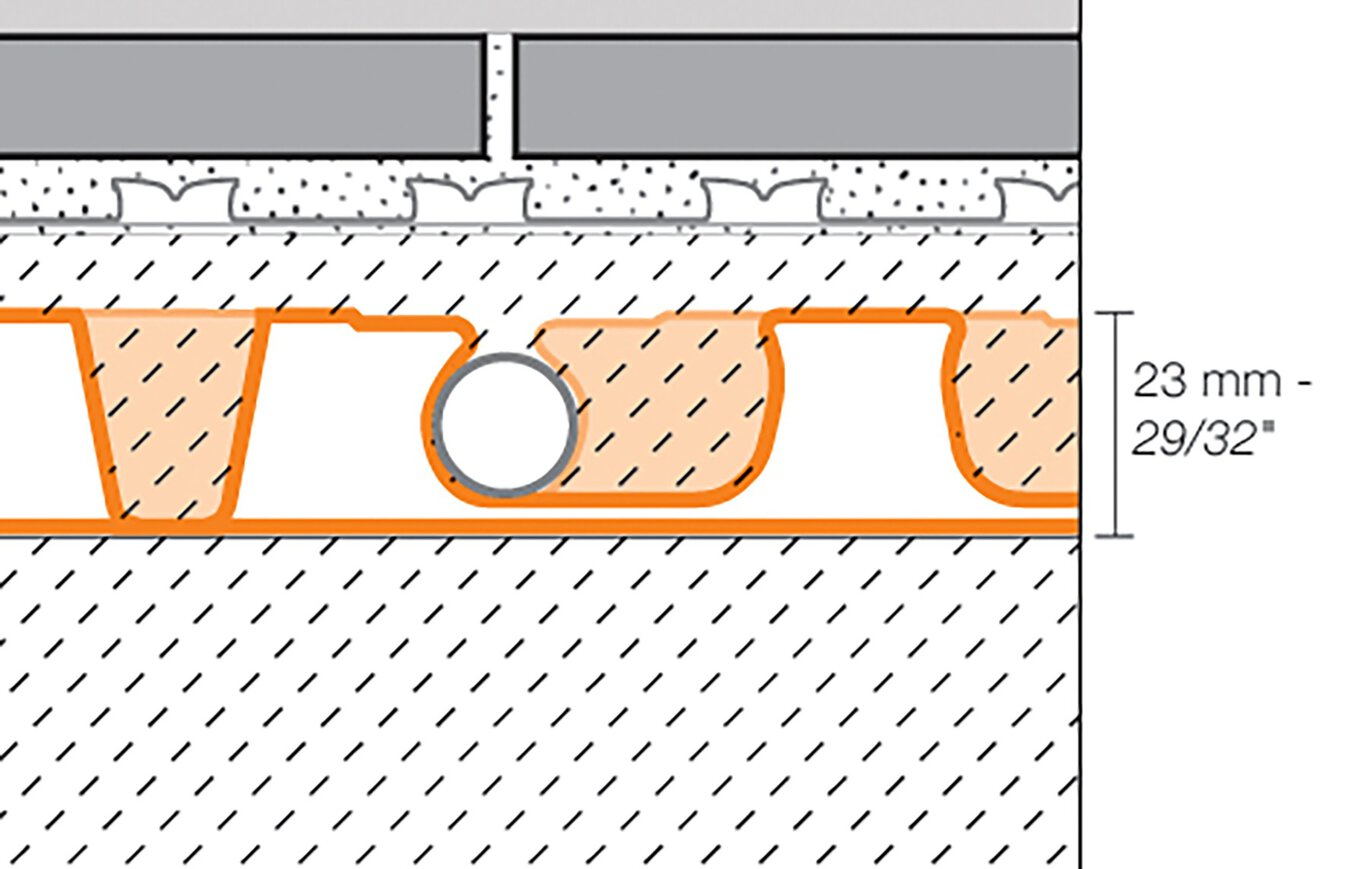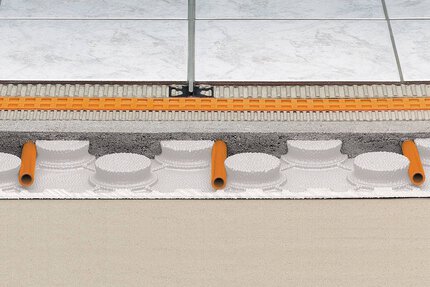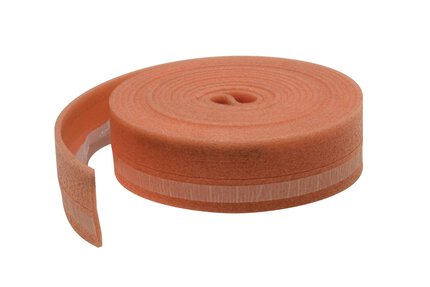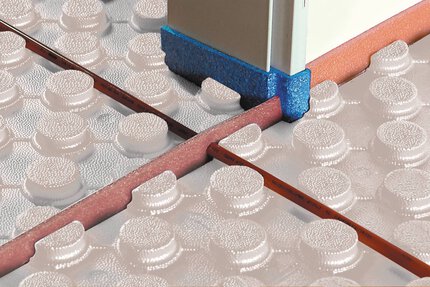Schluter®-BEKOTEC-F
Panel de recrecido modular de 29/32" (23 mm) de espesor
- Produce ensamblados de piso permanentes libres de tensiones internas reduciendo las tensiones de contracción y fraguado a módulos más pequeños.
- Controla deformaciones tales como curvas y grietas continuas, habituales en recrecidos tradicionales.
- Diseñados para utilizar en baldosas cerámicas, piedra natural u otros revestimientos de superficies.
- El panel nodulado de recrecido tiene un espesor de 29/32" (23 mm) y está fabricado de lámina de poliestireno.
Encuentre aquí los accesorios recomendados
Schluter®-BEKOTEC-F es un sistema de recrecido modular que produce ensamblados de pisos permanentes libres de tensiones internas. Los paneles nodulados de poliestireno Schluter®-BEKOTEC-EN23F se colocan directamente sobre cualquier substrato portante y sobre capas comunes con la opción de aislamiento acústico y/o térmico. Los nódulos dividen eficazmente el recrecido en módulos cuadrados más pequeños, de 4-1/4" (108 mm), confinando así las tensiones de contracción y fraguado para controlar deformaciones tales como curvas y grietas continuas que pueden ser comunes en un recrecido tradicional. Estos sistemas de recrecido modular permiten la instalación de superficies de recrecido continuas sin juntas de control ni refuerzos de alambre. La eliminación de las juntas de control permite colocar juntas de movimiento en la superficie para que coincidan con la disposición de las juntas en el revestimiento de baldosas.
La sección transversal del ensamblado revela un espesor mínimo de recrecido de 1-1/4" (32 mm) entre los nódulos y 5/16" (8 mm) por encima de los nódulos. Esto supone un importante ahorro de material y peso con respecto a los recrecidos tradicionales. Por ejemplo, un recrecido de mortero tradicional de 1-1/4" (32 mm ) de espesor pesa aproximadamente 15 lb/pie (20,72 kPa), mientras que un recrecido de mortero BEKOTEC pesa aproximadamente 12 - 12,5 lb pie (20,57 - 0,60 kPa), lo que representa una reducción del 15 al 20%. El ahorro de material y peso en comparación con una capa de mortero de 51 mm de espesor es de aproximadamente el 50%.
Los nódulos forman un patrón cuadriculado, con una distancia de 3" (76 mm) entre nódulos para admitir tubos de calefacción hidrónica de 3/8" (10 mm) a 5/8" (16 mm) de diámetro exterior si se va a instalar un recrecido para calefacción. Dado que la masa del recrecido a calefaccionar es relativamente pequeña, la calefacción del piso puede regularse bien y funcionar a un rango de temperatura bajo.
El sistema de recrecido modular reduce la transmisión del ruido de impacto. Al tratarse de un sistema de recrecido flotante, también es posible incorporar diversos materiales de atenuación acústica debajo del panel, lo que permite una reducción aún mayor del ruido de impacto.
Las baldosas de cerámica o piedra se instalan sobre los recrecidos modulares BEKOTEC-F utilizando las membranas de desacoplamiento Schluter®-DITRA o Schluter®-DITRA-XL. Consulte el Manual de instalación de Schluter®-DITRA (detalle D-C-TS para recrecidos a base de cemento Portland y detalle D-G-TS para recrecidos a base de yeso). Los revestimientos no sensibles al agrietamiento, como el parquet o la alfombra, pueden colocarse directamente sobre el recrecido en cuanto la humedad residual haya alcanzado un nivel adecuado.
Los productos BEKOTEC no se pudren y no requieren ningún mantenimiento especial. Antes y durante la aplicación del recrecido, los paneles con nódulos deben protegerse de forma adecuada (es decir, deben utilizarse estribos para protegerlos de daños mecánicos).
1. BEKOTEC-F se instala sobre un substrato uniforme y suficientemente resistente. Si se requiere aislamiento adicional, coloque una capa de paneles de espuma de poliestireno expandido o extruido sobre el substrato y recubra con una lámina de polietileno.
2. En el perímetro, donde el revestimiento se encuentra con las paredes o las superficies de contención, coloque la tira de borde de 5/16" (8 mm) de espesor, Schluter®-BEKOTEC-BRS o -BRSK. Las tiras de borde tienen una lámina integrada que debe llevarse sobre la capa separadora que recubre el aislamiento. Si se va a aplicar un recrecido vertido, se utiliza la cinta de borde Schluter®-BEKOTEC-BRS/KF o -BRS/KSF con un ala adhesiva. La cinta de borde -BRS/KF se fija a la pared utilizando el ala adhesiva de su parte trasera, mientras que la cinta de borde -BRS/KSF es autoportante. El panel de recrecido se coloca sobre la pata de espuma autoadhesiva de-BRS/KF o de -BRS/KSF para evitar el reflujo del recrecido bajo el panel.
3. Los paneles BEKOTEC-F se conectan solapando una fila de nódulos y encajando los paneles entre sí.
4. Para producir suelos radiantes, se pueden encajar tubos calefactores adecuados, de 3/8" - 5/8" (10 a 16 mm) de diámetro exterior, entre los nódulos recortados. El diseño recortado de los nódulos garantiza la sujeción segura de los tubos sin necesidad de abrazaderas en tramos rectos. Las abrazaderas pueden ser necesarias cuando los tubos se giran en un radio relativamente estrecho. La distancia entre tubos se determina en función de la potencia calorífica deseada.
5. Rellene el panel de recrecido modular con una capa de mortero o recrecido de yeso vertido, asegurando una cobertura mínima de 5/16" (8 mm) por encima de los nódulos. Si se requiere nivelación, el espesor del mortero puede aumentarse hasta 1" (25 mm) por encima de los nódulos. El recrecido puede separarse en el umbral de la puerta utilizando el perfil de junta de movimiento Schluter®-BEKOTEC-DFP para evitar puentes acústicos.
6. En cuanto el recrecido de mortero sea transitable, se puede aplicar la membrana de desacoplamiento DITRA o DITRA-XL. Con respecto a los recrecidos de yeso vertidos, deberá respetarse una humedad residual máxima del 2,0 % en volumen. Sobre DITRA o DITRA-XL se pueden colocar revestimientos cerámicos o de piedra mediante el método de colocación de capa fina.
7. El revestimiento de la superficie sobre DITRA o DITRA-XL se divide en campos con juntas de movimiento de acuerdo con el Manual de instalación de Schluter®-DITRA y las pautas estándar de la industria. La familia de perfiles prefabricados para juntas de movimiento Schluter®-DILEX incluye una variedad de formas, tamaños y materiales para adaptarse a diferentes aplicaciones. Cuando se instala un perfil DILEX perimetral o en forma de mediacaña en la transición piso/pared, hay que recortar primero las secciones salientes de la cinta de borde.
8. Cuando se utiliza el ensamblado de recrecido modular para calefacción radiante, el revestimiento de suelo terminado puede calentarse al cabo de 7 días. Comenzando a 77 °F (25 °C), la temperatura de arranque se incrementará diariamente en 9 °F (5 °C) como máximo, hasta alcanzar la temperatura de trabajo deseada.
9. Los materiales de revestimiento que no se agrietan (por ejemplo, parquet, alfombra o piso elástico) pueden colocarse directamente sobre el recrecido modular
Nota: cuando se utilicen materiales de revestimiento de suelos elásticos, como vinilo o alfombra, se recomienda aumentar el grosor del recrecido sobre los nódulos a 5/8" (15 mm) como mínimo.









